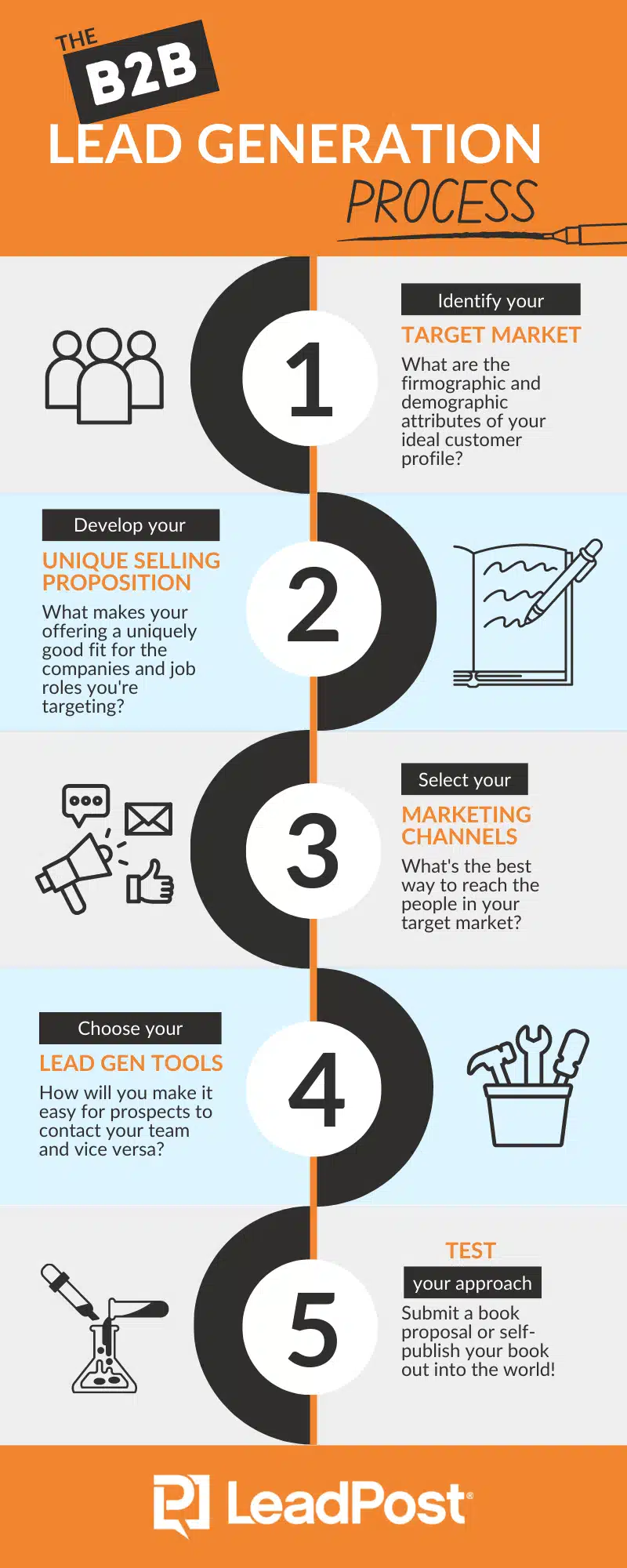Whether you’re trying to grow a new company or increase sales at an existing business, beginning the lead generation process can be intimidating. This is especially true of B2B lead generation. Implementing the strategy and best practices to generate business leads tends to be more challenging than B2C lead generation.
If you decide to DIY customer acquisition instead of relying on a lead generation company, here’s a guide to help. We’ll cover the process, best practices, and some lead generation tools that might help.
The B2B Lead Generation Process
For B2B companies, the lead generation process involves answering the following questions:
- What types of companies are a good fit for your offering?
- What roles do the decision-makers, influencers, and end users of your offering hold?
- What makes your offering a uniquely good fit for these people?
- What messaging highlights that unique fit?
- Where can you deliver that message most effectively?
- How will you make it easy for interested people to follow up with you?
- How will you make it easy for your team to follow up with people who are a good fit?
The answers to this question will also help you develop an effective lead scoring model.

1. What types of companies are a good fit for your offering?
The first two questions will define your ideal customer profile. First, you’ll determine the firmographic attributes of the companies in your target market.
Depending on your budget, how well your company is established in the market, and other factors, determine a realistically sized audience to target. If you’re a new company or you have a small budget, zero in on the companies that will be the very best fit.
2. What roles do the decision-makers, influencers, and end users of your offering hold?
Next, you’ll identify all potential stakeholders and as much of their demographic, geographic, psychographic, and behavioral attributes as possible.
3. What makes your offering a uniquely good fit for these people?
Based on your ideal customer profile, you need to establish a unique selling proposition. Why should this type of person at this type of company choose your offering over a competitor’s?
4. What messaging highlights that unique fit?
Once you establish your unique selling proposition, you need to determine how you will convey that proposition to your target market. Different categories of stakeholders who you will target with your market efforts may require different messaging.
For example, an entry-level employee may like how easy a software solution makes it to generate reports, while their boss likes the visibility it gives them into day-to-day operations.
5. Where can you deliver that message most effectively?
At this point, you should have determined your target audiences (or audiences) and the message (or messages) you’ll deliver to them. Now it’s time to figure out the best way to deliver it.
Which marketing channels will you focus on?
6. How will you make it easy for interested people to connect with your team?
Identify the tools you’ll use to connect potential customers with your team. This could be anything from co-browsing software, to live chat, to forms, and beyond.
7. How will you make it easy for your team to follow up with people who are a good fit?
What tools will you use to actually generate the leads? You’ll need a tech stack that includes a CRM, marketing automation, website visitor identification software, and other tools to make it easy to follow up with prospects.
B2B Lead Generation Tools
There are a lot of tools available to make your life easier. You don’t need all of them (or maybe even any of them) but they can speed things up.
Here are some of the tools to look into along with links to explain more about them:
- 5 Landing Page Optimization Tools to Increase Your Conversion Rates
- How to Get Better Results with Salesforce Journey Builder
- Check Out These 8 Unique Lead Capture Software Solutions
- 3 Awesome Email List Building Tools to Grow Your Audience
Generate and Close Your Own Leads
The seven steps above are an easy framework to get you started generating, qualifying, and closing leads. The technology we use to do it may change, but these fundamentals have always been the same. To get started, check out our B2B lead capture tool and we’ll give you some free leads to get you started.
